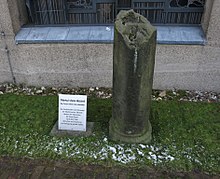Body donation

As a body donation, a donor bequeaths his corpse to an anatomical institute or its university for teaching and research purposes or for plastination . The motive for a body donation can be to promote medical research or the scientific training of medical students in the dissection course or to provide financial relief for surviving dependents.
In the past, the institutes covered all or part of the costs for the funeral . Since the elimination of the statutory death benefit (only applies to Germany) in January 2004, the body donor has to regulate the funeral costs himself in advance, for example through
- a death benefit insurance
- Creation of a savings account for the benefit of the university or
- a testamentary estate disposition .
This amount can be used to cover the costs that arise later (transportation, cremation, cemetery fees, etc.) on the part of the university. If funding is not secured at the time of death, the university can refuse to donate the body.
method

If you want to donate your body, you have to sign an agreement with a relevant institute while you are still alive. This agreement can generally be canceled at the donor's request, which may incur costs. Surviving dependents can neither revoke the agreement nor release a deceased relative for the body donation without their consent. The considered institute does not automatically find out about the death of the body donor. Therefore, body donors are advised to communicate their decision to their relatives.
conditions
The deceased are usually not accepted despite an agreement,
- when severe injury have
- if you had a strongly infectious disease (according to the Infection Protection Act )
- when right medical or pathological autopsy were
These reasons for exclusion do not apply in Austria .
Other conditions differ depending on the beneficiary institution. Pay attention to the following points, for example:
- costs
- Can the body donor also be an organ donor ?
- Up to what distance are the costs for the transfer of the corpse covered?
- What happens if the body is not accepted? Will cost contributions already paid be reimbursed?
- Does the institute - provided all conditions are met - undertake to take over the body and incidental funeral costs?
- What happens to the remains after the work is completed?
Some institutes only accept donors above a certain age.
Examples
In some years the Medical University of Vienna temporarily did not accept any new agreements for body donations due to excess supply. Thereafter, a contribution to costs was introduced, in 2006 in the amount of 400 euros, in 2011 in the amount of 450 euros. In 2017 the fees are 990 euros. This amount is payable with the conclusion of the agreement.
At the Institute for Anatomy and Cell Biology of the Martin Luther University Halle-Wittenberg , body donation is no longer free of charge since September 2006. A contribution to the funeral costs of 750 euros is required (plus any transportation and other costs incurred).
A memorial service for deceased body donors is held once a year at Vienna's central cemetery shortly before All Saints' Day, and there is an honorary grave stone or, more recently, an urn grove where relatives of body donors can worship.
Body farms for research in forensics represent a special form of body donation .
Web links
- Information on body donation to the University of Saarland , Homburg
- Information on body donation from Heidelberg University
- Information on body donation by the Charité Universitätsmedizin Berlin
- Information on body donation from the Medical University of Vienna
- Information on body donation from the Medical University of Innsbruck
- Information on body donation by Dr. Senckenberg anatomy at Johann Wolfgang Goethe University , Frankfurt am Main
- Information on body donation from the Christian-Albrechts-Universität zu Kiel
- Information on body donation from the Institute for Anatomy at the University of Bern
Individual evidence
- ↑ Bodydonation ( Memento from January 1, 2007 in the Internet Archive )
- ^ Information sheet on body donation for the Medical University of Vienna. (PDF) Retrieved October 12, 2017 .
- ↑ Body donation / Prosecture - on the University Medicine website, accessed November 23, 2015.
